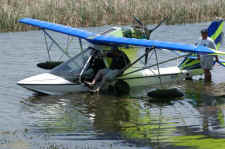| Unlike the Buc II which used a center mounted throttle the throttles on the Aventura II are comfortably located on the left and right hand side of the plane on the side armrest tubes. The rudder is operated by cables, the elevator and aileron controls use teleflex cables. The craft comes standard with electric flaps, with the actuator switch located on the dash. The manual elevator trim tab is located between the seats. The Aventura II is available with a manual retract system, or an electric retract. Both systems retract the the main landing gear and the tail wheel at the same time. For the manual system a "Johnson Bar" is located forward of the pilots in the center between the seats. The pilot reaches forward releases the gear and pulls back which raises the gear. To lower the gear he again releases it and gravity brings the gear down where it locks into place. The electric system which is considerably stronger allows the use of larger wheels, and can actually lift the plane. The control is again located in the center forward of the pilots. Activation of the gear is via a control lever, you push it forward to retract and back to lower the gear. The electric system has two lights which show whether the gear is up or down and locked. Green light means your landing on grass. Blue light your landing on water. The instrument panel stretches from one side of the cabin to the other allowing for pretty well any instrument configuration a pilot could want. Easy access to the rear of the panel is achieved by removal of a front hatch cover. Entering the Aventura II for the first time can be a little awkward as unlike the Buc II there are no down tubes to grab onto to help enter the cockpit. Pilots face forward, shorter pilots can step on the wheel with one foot, and then enter the cabin by placing their other foot on the seat and then sliding down into the seat. Taller pilots will support themselves with one foot while stepping into the craft, using their arm for support and sliding into the seat.  One of things pilots must consider when they are looking at this type of aircraft is that, unlike a float plane that can be pulled up to a dock so people can board, this style of aircraft with the sponsons out on the wing, and a center hull is difficult to dock. One of things pilots must consider when they are looking at this type of aircraft is that, unlike a float plane that can be pulled up to a dock so people can board, this style of aircraft with the sponsons out on the wing, and a center hull is difficult to dock. This means that you need a specially constructed dock which allows for the sponsons, or have a ramp or area where you and can drive the plane in and out of the water. If neither is available - you are going to get wet, getting in and out of the plane. The pilot seats are a very thick and comfortable sling style, supported at the back and front. There are a set of storage pockets on either side for storing maps etc. The plane flown for this report had seat belts with shoulder harnesses. There is another storage area above the fuel tank behind the pilots, and the craft can be fitted with a storage area under the front deck lid. Pilots are protected from the wind by a large windshield, which has a set of side deflectors located about head level on the side of the windshield. These do a very good job of defecting the wind away from the pilot when flying. The craft comes standard with a 12 gallon fuel tank, which can be upgraded to 18 gallons. The Aventura is fueled from outside of the cockpit via a fuel filler located just behind the pilot enclosure under the wing. Forward, side, and rearward visibility is excellent, because of the large windshield, and no doors which allows the pilot to actually stick his head out to view backwards. A set of rear windows panels also add to the good visibility. For those needing to transport the plane the wings can be removed by two people in about 30 minutes. The rudder, elevator and horizontal stab can also be removed in about the same time. |